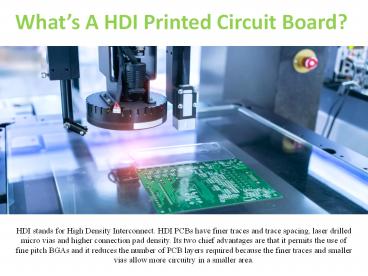What’s A HDI Printed Circuit Board? - PowerPoint PPT Presentation
Title:
What’s A HDI Printed Circuit Board?
Description:
HDI stands for High Density Interconnect. HDI PCBs have finer traces and trace spacing, laser drilled micro vias and higher connection pad density. Its two chief advantages are that it permits the use of fine pitch BGAs and it reduces the number of PCB layers required because the finer traces and smaller vias allow more circuitry in a smaller area. – PowerPoint PPT presentation
Number of Views:33
Title: What’s A HDI Printed Circuit Board?
1
Whats A HDI Printed Circuit Board?
HDI stands for High Density Interconnect. HDI
PCBs have finer traces and trace spacing, laser
drilled micro vias and higher connection pad
density. Its two chief advantages are that it
permits the use of fine pitch BGAs and it reduces
the number of PCB layers required because the
finer traces and smaller vias allow more
circuitry in a smaller area.
2
Narrow trace widths mean higher circuit density
At PNC standard PC Board fabrication uses a
minimum trace width of 5 mil, with a 5 mil space
between traces (5/5mil) PNCs HDI trace widths
can be as narrow as 3 mil with 3 mil spacing.
These finer traces allow 160 more traces in the
same real estate. 3/3mil spacing will also allow
two traces to escape between pads of a standard
BGA, meaning less PCB layers are needed to fan
out the pins from the BGA.
3
Microvias are the enabling technology for HDI
Narrow trace widths used in HDI PC Board are a
result of the gradual refinement of
photolithography and etching technology.
Microvias on the other hand, are a revolutionary
innovation driven by the development of high
powered lasers that can be controlled accurately
enough to ablate a 3 mil hole through the surface
layer of copper and underlying laminate, without
damaging the underlying layer of copper.
4
The minimum hole size for PNCs laser drilled
microvias are 3 mil and the minimum pad diameter
for the microvia is 7 mil. Pads for laser drilled
holes can be smaller than for mechanically
drilled holes because of the location accuracy of
the laser drilled hole. There is no mechanical
deflection of the drill bit to account for. The
laser drilled holes can be fully copper filled
and planarized flat, so they can be used as pads
for fine pitched BGAs with 0.4mm or smaller
spacing. Using microvias as pads allows the
signal trace to fan out by going straight down
and out to an inner layer of the printed circuit
board.
5
The biggest limitation with microvias is the
aspect ratio of the holes. Where a drilled
through hole can have a 101 depth to diameter
aspect ratio, a laser drill can achieve no more
than around a 11 aspect ratio. This means that
the smallest microvia can only connect two
adjacent copper layers. A larger diameter
microvia can penetrate two layers. To connect
deeper layers, the designer must stack vias one
directly atop another.
Laser drilling of the microvias changes the way
PCBs are fabricated and gives the designer
flexibility that they do not have with through
hole vias. In a standard drilled PCB, via holes
are drilled and plated after the PCB fabrication
stack-up is completed. Because the microvias can
only bridge two or three copper layers, the
microvias must be drilled and plated at each
lamination step. This means that microvias can be
fully buried between layers, stacked or staggered
to allow the microvia to connect multiple layers
of the stack up.
6
The major space saving advantage of the microvia
technology is that vias can just connect traces
that need to be connected, rather than taking up
real estate all the way through the PCB the way a
through hole via does.
The Printed Circuit Board designers at PNC take
advantage of this by locating the power and
ground layers at the top of the stack up. Since
all active components access power and ground,
sometimes through multiple pins, having the power
and ground layers directly below the component
layer allows all those connections to be made
directly by microvias. This leaves the component
layers and layers beneath the power and ground
layers completely unobstructed for signal
routing. This has the added advantage of reducing
parasitic capacitance because it eliminates the
circuit stubs caused by plated through holes.
7
Two sided boards are typically fabricated with a
combination of through holes and microvias.
Though holes can be drilled just through the
core, connecting the stacks on the top and bottom
of the board from the lowest layer, or through
holes can be drilled through the entire stack
directly connecting the traces on the top and
bottom component layers.
HDI PCBs are a necessity when using fine pitched
BGAs, but they can also reduce cost on PCBs
without fine pitched BGAs because of the reduced
layer count. On your next PCB design, talk to the
experts at PNC. They can help you determine if
HDI technology is can reduce your PCB cost by
reducing layer count and shrinking the PCB size.
8
Contact Us
Address PNC INC, 115 East Centre
St. Nutley, NJ, 07110
Phone (973) 284-1600
Email sales_at_pnconline.com































